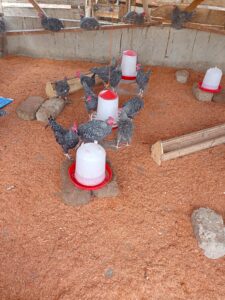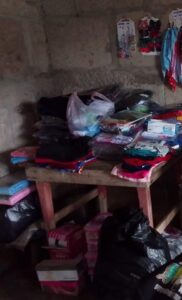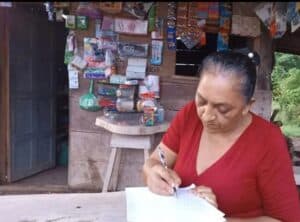From Traditional to Technical Planting Method

Petronila is from the La Venada community, located about 15.53 miles from the city of San Carlos, Río San Juan. She is 43 years old and married with 5 children, although four of her children are already married and live on their own.
Petronila comes from a family of farmers, hard workers, fighters, and lovers of the land. Since she was very young, she has worked in the fields with her father, being recognized for those jobs throughout the whole community. She did not have the opportunity to attend school, having little literacy knowledge, she does have a lot of knowledge related to agriculture from the practice she has had over the years, “I like what I do,” she commented. Petronila does not have her own land to dispose of and sow, but she works on her father’s land or rents from neighbors during planting seasons in order to have a place to sow varieties of grains for her to harvest and to survive. She says that she has never had to emigrate to other community or countries due to lack of work. She does everything what it is necessary for her and her family to survive- working the land along with her husband on neighboring farms doing field work, such as planting any variety of grains, sawing wood, clean the land, and harvesting.
Petronila recounted her experiences of working with Self-Help International by saying:
The Agriculture Program Officer was talking with my sister who is part of the Women’s Empowerment Program group promoted by this organization, then my sister told me that he was a technician who works with farmers (men and women) and that he was promoting the new double row planting technique using the QPM corn variety (High Quality Protein Maize), this project seemed very interesting to me, and even though I have never liked being in those groups, I suggested to my sister to form a group where I could participate on and learn this new planting system and also to obtain the new INTA – Nutrader corn variety.
We (my sister and I) formed a group of 8 farmers (5 men and 3 women) including me. We had a visit from the technician once again, but this time it was to explain us what the work would be and let us know everything related with the INTA Nutrader corn variety, and the implementation of the double row technique for better use of the land and its yields.
Afterwards, we (each group member) received a donation of 4 pounds of the INTA Nutrader corn variety and the program technician along with us implemented a demonstration plot on the land of one of the members. Two weeks later I sewed my corn in an area that my father lent me to carry out this project, this is the first time that I have carried out this type of sowing (double row planting technique), this new methodology takes more time to sow since it doubles the amount of seed and it took me a whole day to achieved it since generally when planting the same amount of corn in the traditional way it would normally take me a few hours, but also I know that the yield would also be low if I did the traditional way. And, in the case of the double row technique, I was expecting a higher yield.
I want to emphasize that everything we do in the planting process is done manually and traditionally even if we implement the double row planting method, I always kept my plot clean of weeds using my machete as my only tool and the only application of inputs that I managed to do was the application of a small portion of chemical fertilizer due to lack of money, but at least with this application I will have a higher yield.
In some point I was doubting at this type of planting (double row) method and asked myself if this double row methodology would really work, because I saw that there were too many plants in a very little space. But the first thing that surprised me was to see that this variety is quick to give its products compared to the ones I have had experience with, because I kept track of the days from when I planted this corn until the plant began to give ears, I counted the days and the corn was ready after 60 days of the planting date, in addition it shows good coverage on the corn which prevents ear rot before being harvested, these are important characteristics to take into account when we want higher yields.
Even with all the setbacks we had this year with the climatic situation where the rains have been very pronounced in the area, making it difficult to dry the grain, I noticed that this variety is resistant, and despite the adversities I harvested 6 quintals (10.70 bushels) of corn out of the 4 pounds of INTA – Nutrader corn received from Self – Help International.
Out of the 10.70 bushels of corn that I harvested, I selected ½ bushel to be use as seed for the next next planting season and stored it into plastic Coke beverage containers. The remainder of corn, 10.20 bushels, were for my family consumption.

From what I have learned and experienced with Self – Help International, I have deduced that if I use the same variety of corn, and follow the same double-row sowing process, and give the appropriate technical management, I can achieve double yield of what I usually obtained with my traditional sowings process, which is why I have planning to plant in the next season planting ½ mz (0.86 acres) of land even though I have to rent this area as I don´t own land on my own, but I considered that it is worthy to make this type of changes and investment on my life as I know I will get more yield meaning more benefits (I can have enough corn for me and my family daily meal plus I can raise some chickens or pigs which can allow me to sell them in the future and obtain extras incomes.
I also obtained from Self Help International the donation of 10 pounds of Biofortified beans (INTA Bioapante) variety, which, like the corn, it adapts to the climate where I live. This variety has good characteristics of resistance to pests and good load of the earn, I cannot comment much on this one yet, since it is still in the drying stage but I hope to be able to harvest enough to save seed to continue the reproductions of it for my family feeding purposes and to share with other farmers in my region as agreed with the Agriculture Program Technician so that they could also have the benefit of this new variety of beans. As I mentioned above, the heavy rains affected the planting of beans in our region and with this new variety that Self-Help International provided us, we intend to implement a Community Seed Bank where other farmers can receive this type of seed for the next planting season and so on keep working with this new strategy to face any shortage of seed in the future.
I am grateful to Self – Help International for the training sessions, techniques, and technologies you taught us, I hope to continue working with you and I want to let you know that I will be always available for any event as I like to learn new techniques that will benefit the production.
Thank you for your support for the most vulnerable sector because agriculture is a risk that must be taken to produce food, exposed to different climatic situations that are sometimes favorable or unfavorable and thanks to the help you give through new varieties resistant to these climatic phenomena we can cope with all this.




